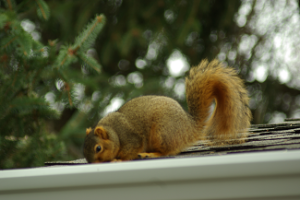What Does Squirrel Chewing Damage Look Like?
By Chris Williams on August 7, 2015.
We’ve noticed some roughed-up places around our roofline on the boards that edge the roof, no actual holes but some spots that look like something tried to start a hole. Could this be from squirrels? We do have plenty of squirrels on our property but this is something new.
F. L., Hollis, NH

What you’re seeing could certainly be gnawing damage from squirrels. Consider yourself lucky that none of them have managed to chew an opening into your attic. When that happens, you have another problem…or two.
It’s usually a female squirrel that takes a notion to move into that nice, protected attic space, and it often happens when she is pregnant. Squirrels almost always enter homes at the roofline. It’s usually easy for them to get onto roofs and find fascia boards or soffits that are often unpainted and softened from water damage or rot, or weakened by insects. Squirrels don’t just chew wood, they will also gnaw plastic, cement, or just about anything but metal in order to gain an opening.
Squirrels will also try to chew an opening in or around attic louvers or ventilators, joints of siding, eaves of roofs, knot-holes or woodpecker holes in siding, openings where utility lines enter, and flashing around chimneys, to name a few. If a squirrel can find a small opening or an edge that it can get a purchase on with its teeth, it’s no problem to gnaw to enlarge that opening.
The actual gnawed hole will vary in size and shape, depending on the location and the size of the squirrel, but it is usually 1-1/2 to 3 inches across, and in the shape of a semicircle, depending on the material chewed. Squirrels like to have more than one opening. Openings that have been in use for some time may have dark rubmarks around the edges from oils in the animals’ fur.
How Can You Keep Squirrels Out of Your Attic?
Odor repellents like mothballs will not keep a squirrel out of an attic (that’s an illegal use for mothballs anyway). Commercial or homemade taste repellents painted on the wood will sometimes work for a while. If that squirrels really wants into that attic, it’s tough to discourage her. If you manage to stop her from chewing at one opening, she will just start another nearby.
The best solution once the chewing has begun is to trap and remove the offending squirrel, then seal openings, squirrel-proof the rest of the house, and make it less attractive as a chew toy.
You can avoid this whole scenario by proactively making changes to your home that will discourage squirrels from ever starting the process. We call that approach squirrel-proofing and we have a team of technicians that are experts at dissuading squirrels. Squirrel-proofing means finding and sealing up any areas that squirrels can use to get inside, reinforcing weak areas, screening and caulking future entry points, installing chimney caps, replacing rotting wood, etc. Give Colonial Pest a call today and ask about our squirrel exclusion program.
For more on squirrels chewing their way into attics, check out these Colonial Pest blogs:
- How Do Squirrels Get Into Attics?
- Who Chewed That Hole in the Soffit?
- Gnawing Damage Around Your Roofline?
Photo Credit: By Moxfyre [GFDL (http://www.gnu.org/copyleft/fdl.html) or CC BY-SA 4.0-3.0-2.5-2.0-1.0 (http://creativecommons.org/licenses/by-sa/4.0-3.0-2.5-2.0-1.0)], via Wikimedia Commons